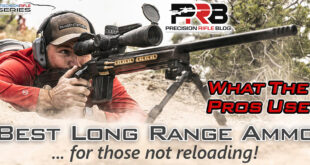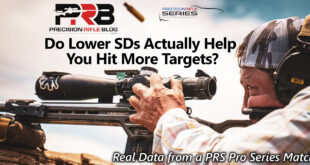After I identified a promising range of powder weights using Audetter’s ladder test, my next step was to use Dan Newberry’s Optimal Charge Weight (OCW) Method to offset the “scatter node” drawback inherently present in the ladder test. To learn more about that, read this article comparing the OCW method with the ladder test.
The OCW method is based on the observation that there are some loads out there (like Federal’s match ammo for the 308) that shoot really well out of just about any rifle. How can one recipe shoot so well out of so many different rifles? Dan Newberry believes accuracy of great “pet loads” are due to how well they match up with the shockwave that traverses a barrel when firing a rifle. The theory behind it is kind of complex, so for more info … see Dan’s overview on how it works.
Although the theory behind the OCW method is complex … it’s actually pretty easy to perform. You simply identify a range of powder weights you want to try, fire a 3 shot group of each powder charge, then identify the groups that come closest to hitting the same point of impact (POI) on the target. As Dan Newberry examples, “The trend of the groups should be obvious, normally going from low and favoring one side, to high and favoring the other side. But along the progression, there should be a string of at least three groups that all hit the target in the same relative point.” You can then choose the powder charge that represents the center of that string, which should be a very “pressure tolerant” or “resilient” load. That should mean that slight variations in pressure due to differences in powder charge, primer “hotness”, neck tension, bullet runout, etc. won’t have have a dramatic input on groups.
Based on my results from the Audette’s Ladder test, I decided to try the Berger 168gr VLD over Retumbo powder ranging from 68.9gr to 70.1gr. Note: The OCW method recommends jumping in 3 grain increments for magnums, and 2 grain increments for standard cartridges. Sorry I didn’t record velocities … it was already too dark for my chronograph when I started.

I likely pulled the 1st (highest) shot on the target above. I called it before looking at the point of impact. It just didn’t feel like a clean break.
The white cross on each target represents the center point of impact (POI) for each 3-shot group. What we want to do now is look for the 3 targets where that white cross is the closest to the same position. You can see the POI for the first group was well below the bull, the 3 middle targets all group just to the right and slightly above the bull, and the last target grouped ever higher up well above the bull. Here is a graphical summary of the POIs from each of the 5 targets. You can clearly see targets 2, 3 & 4 had virtually identical POIs.
So based on results from the OCW method, it’s pretty clear cut that 69.2gr to 69.8gr have very similar point of impacts. That not only confirms the results from the ladder test, but gives me further detail about where the most accurate and “resilient” load is … right around 69.5gr of Retumbo. Next time I’ll test 5 shot groups at more precise powder weight increments in that range, and hopefully zero in on my final powder charge.
Note: The software I used for the target analysis shown here is very handy when doing load development, and fairly simple to use. It’s called OnTarget, and just costs $12. Here is a link to their website: OnTargetShooting.com.
Jump to another step:
- Part 1: Bullet Selection & Real-World Velocities
- Part 2: Audette’s Ladder Test
- Part 3: Optimal Charge Weight
- Part 4: 5 Shot Groups
 PrecisionRifleBlog.com A DATA-DRIVEN Approach to Precision Rifles, Optics & Gear
PrecisionRifleBlog.com A DATA-DRIVEN Approach to Precision Rifles, Optics & Gear










Hello sir
I had a quick question I can’t seem to find a straight forward answer on. So i was performing the same OCW test with a 7mm using 180 gr Bergers but in a round robin format. As I was shooting I notices one of the groups was smaller than a dime while the others averaged one inch. Also this load was one of the ones within the three at the same POI should I ignore this or take this into consideration as well.
Thank you I love your website
Wow, Andrew. I’m not sure what to tell you. That doesn’t match my experience with the OCW test, but it does sound like you have an data that can help you make a decision. If you’ve got a load that shoots smaller than a dime, I’d stop!
I’ve talked to Bryan Litz about this recently, and we’ve both come to a place where we realize that most of spend too much time tweaking and perfecting a load. Both of us thought that for practical long-range shooting, once you found a load that shot under 1/2 MOA you might be better served to stop tweaking the load and just go shoot it a lot. Constantly tweaking the load can undermine your confidence in your dope, which can cause more misses than a load shooting 0.25 MOA over one that shoots 0.35 MOA. I just wasn’t in that mindset when I originally started into this game, so it’s quite a paradigm shift for me and just something that I started thinking since the “How Much Does It Matter” series of posts I published earlier this year.
Hope this helps, and sorry I couldn’t give you more specific direction.
Thanks,
Cal